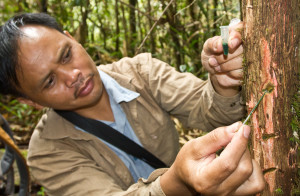 Trees could be a source for miners, using the ability of some plants to isolate and accumulate metals in their shoots. University of Queensland Sustainable Minerals Institute researcher Dr Antony van der Ent said ‘hyperaccumulator’ plants that could extract metals such as nickel or cobalt from the soil could be harvested for significant returns. “A mature nickel hyperaccumulator tree can contain up to five kg of nickel metal when grown in the right conditions,” Dr van der Ent said. He said the process, known as phytomining or agromining, could involve plantations growing on mine waste or ground with ore deposits not suitable for traditional mining.
Trees could be a source for miners, using the ability of some plants to isolate and accumulate metals in their shoots. University of Queensland Sustainable Minerals Institute researcher Dr Antony van der Ent said ‘hyperaccumulator’ plants that could extract metals such as nickel or cobalt from the soil could be harvested for significant returns. “A mature nickel hyperaccumulator tree can contain up to five kg of nickel metal when grown in the right conditions,” Dr van der Ent said. He said the process, known as phytomining or agromining, could involve plantations growing on mine waste or ground with ore deposits not suitable for traditional mining.
“Phytomining trials have yielded up to 200 kg of nickel per hectare per year, establishing a potential opportunity and income stream for future metal farmers in developing countries, especially with nickel worth around $19,000 a tonne,” scientist said. Dr van der Ent, a postdoctoral researcher with SMI’s Centre for Mined Land Rehabilitation, said the technology had been scientifically proven over the past 20 years, but the mining industry had not adopted it at a significant scale. “This may be the result of a lack of minerals industry awareness of the technology’s potential or of the scientific advances that have been made in metal recovery from plants. Industry needs to be encouraged to adopt new technologies that have the potential to improve mine site rehabilitation outcomes and opportunities, especially in developing countries in the Tropics,” he said.
Dr van der Ent said harvesting and incinerating plant biomass generated a commercial high-grade bio-ore containing 10 to 25 per cent nickel. “Its purity means it’s uniquely suited to produce organic chemical industry nickel catalysts or high-value nickel chemicals for use in electroplating.” The SMI held the world’s first Phytomining Workshop earlier in the year, where scientists, engineers and industry partners discussed the future of the unique technology. Global phytomining experts emphasised a need to ensure the preservation of rare hyperaccumulator species and their habitats, and planned to develop a Global Hyperaccumulator Database to document key knowledge about the plants.



